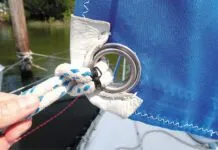Delaminated Decks
Im still looking for my good deal. I found a 1977 Columbia 9.6 in not too bad a shape except for two problems. The plywood hatches are goners (easily replaceable) and both side decks are delaminating. It appears that water was allowed in through the shroud chainplates.
What is the best way to deal with this problem? I read the procedure in This Old Boat, but I don’t think Im up for replacing the core and glassing a new deck over that. I had the bright idea of perhaps installing a teak deck. Have you ever done a piece in your newsletter on this subject?
What would you recommend: 1) replace the deck, 2) cover the deck with teak, 3) another approach, 4) pass on the whole thing?
Jens Wrage
Rochester, New York
Delaminated decks are a major problem with older fiberglass boats. Having observed several persons attempt repairing them, and read of others, our personal conclusion is to avoid the boat altogether. Weve done just about every unctuous job there is to do on an old boat, except this one, and well continue to give it a pass.
Drilling holes and shooting epoxy in seems like a dubious solution. It might work for small areas of delamination, but for larger areas, the only cure is to remove the core. This can be done by removing the inner liner, removing the funky core, then epoxying new core to the underside of the fiberglass top. Then you have to cover the balsa or foam core with more glass, all working upside down. Its a nightmare, though people have done it.
Weve also seen a friend pop the entire deck off a small boat, pry the top skin off the core and bottom skin, then start reaching in and scraping out the wet balsa. Nothing is easy.
Adding teak on top does not seem like the right solution either. Its heavy, labor intensive, and while it will add some initial stiffness, the core will continue to rot, allowing increasing flex in the structure.
One of the few positive experiences weve heard about was from reader Ginger Tomlinson of Annapolis, Maryland. We published her letter in the March 15, 1994 issue. On her Cal 28, which had no fiberglass headliner, she removed the rotten core (plywood in this case) and glassed in new plywood. She said it wasnt so bad. Still it was a lot of work, and our opinion of this repair hasn’t changed. Its one thing if you already own the boat and have no overhead liner, another matter entirely if you havent bought the boat yet and can avoid the job altogether.
Considering the large number of used boats on the market, many at great prices, why buy one with major structural problems? Maybe youll end up paying a few thousand more than you would for this good deal, but if it has a sound hull, deck, keel and rudder, youre miles (and dollars) ahead. Our advice is to keep looking.
VHF In The Cockpit?
Were new to cruising, and on our new (to us) sloop we want to install a permanently located VHF radio. Because its usually the helmsman who wants to use the radio (to call other boats and ships, signal to bridges, etc.), does it make sense to install the radio in the cockpit?
The boat has a nice lazarette; we could even make a small slot in the side of the wood lazarette box to take the mike cord if we wanted to use the mike but close the lid. Its a good secure place to keep the radio, out of the weather but handy for use. What do you think?
Phil Meyers
Seattle, Washington
We know of several sailors who have opted for the cockpit location. For a single-hander or anyone who sails short-handed, it makes eminent sense.
However, working the radio and steering at the same time might be difficult, especially when maneuvering in tight quarters. And what happens when youre at anchor, sitting below, and want to tune in the weather? Do you go stand in the cockpit?
And, because theres always the possibility that, while using the radio, it might get doused, consider buying a set that is weather-resistant. Most fixed-mount radios are not waterproof, though some are sealed better than others. You might want to review, in the July 15, 1997 issue, our latest tests of top-flight VHFs. The Icom IC-M59 was a Best Buy among high-end models (costing more than $250 at discount). Among low-end models, reported in the February 1, 1997 issue, we liked the Apelco 8500 and 4500 radios. In the upcoming December issue, check out the Standard Nova+ with full-featured remote RAM mic; that may just be the one for you.
Our choice, however, would be to have a fixed-mount VHF below, at the nav station, and carry a waterproof handheld VHF for use in the cockpit. The Icom IC-M1 made our 1997 Top Ten Product list, as reported in the November 1, 1997 issue. We also like the Uniden HH-940.



































